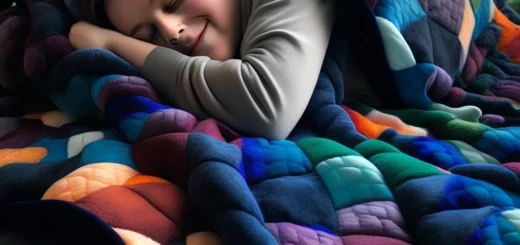The Surprising Benefits of Weighted Blankets for Individuals with Autism Syndromes

Weighted blankets are a popular therapeutic tool that can benefit individuals with autism syndromes. These blankets are designed to have extra weight, which can provide a sense of deep pressure and comfort to the user. This pressure can calm down the nervous system, reducing anxiety and promoting relaxation.

For example, when a child with autism syndrome feels overwhelmed or anxious, a weighted blanket can provide a sense of grounding and support. The blanket’s deep pressure can help calm their nervous system and regulate their emotions, making it easier for them to cope with their environment and reduce meltdowns or tantrums.
In addition to their calming effects, weighted blankets can help sleep. Many individuals with autism syndromes have difficulty with sleep, and weighted blankets can provide the pressure and comfort needed to promote a restful night’s sleep. For example, if a child with autism syndrome has trouble falling asleep or staying asleep, a weighted blanket can help them feel more secure and relaxed, making it easier to drift off to sleep. By improving sleep, weighted blankets can also help with overall mood and behavior during the day.

When choosing a weighted blanket for an individual with autism syndrome, it’s important to consider their size, weight, and sensory preferences. The blanket should be large enough to cover the entire body, and the weight should be evenly distributed across the blanket. For example, a child who is 50 pounds may need a weighted blanket that is 5-8 pounds, while an adult who is 150 pounds may need a weighted blanket that is 15-20 pounds. It’s also important to choose a blanket made of soft, breathable materials that are comfortable to touch. For example, a weighted blanket made of plush fleece or cotton may be more comfortable and soothing than synthetic materials.

It’s also important to consult with a healthcare provider or therapist before using a weighted blanket. They can help you determine the appropriate weight and size for the individual and guide how to use the blanket safely and effectively. For example, a therapist may recommend starting with a lighter-weight blanket gradually.
How weighted blankets can provide benefits for individuals with autism syndromes:
- A child with autism syndrome feels overwhelmed by a loud and chaotic environment. Their parents use a weighted blanket to provide a sense of grounding and support, and the deep pressure of the blanket helps to calm their nervous system and regulate their emotions. As a result, the child can cope with the environment and avoid a meltdown or tantrum.
- A teenager with autism syndrome has difficulty falling asleep and staying asleep. Their therapist recommends using a weighted blanket to provide the deep pressure and comfort needed to promote a restful night’s sleep. After using the weighted blanket for a few weeks, the teenager’s sleep improves, and they can wake up feeling rested and refreshed.
- An adult with autism syndromes experiences anxiety and panic attacks. Their therapist recommends using a weighted blanket to help calm their nervous system and reduce anxiety. The deep pressure of the blanket provides a sense of safety and security, and the adult can use it to help manage their anxiety symptoms during stress.
- A child with autism syndrome has sensory processing challenges and is sensitive to certain textures and materials. Their parents use a weighted blanket of soft, breathable cotton to provide the deep pressure and comfort needed to regulate their sensory input. The child can use the weighted blanket during activities and transitions, and they find it helpful in managing their sensory needs.
These are just a few examples of how weighted blankets can benefit individuals with autism syndromes. W weighted blankets can help regulate sensory input, reduce anxiety, and improve sleep by providing a sense of deep pressure and comfort. If you are considering a weighted blanket for an individual with autism syndrome, consult a healthcare provider or therapist for guidance on choosing the right blanket and using it safely and effectively.
There are a few potential disadvantages of using weighted blankets for children with autism syndromes. Here are a few possible disadvantages to consider:
- Weighted blankets can be expensive. Weighted blankets are often more costly than regular blankets, and the cost may be a barrier for some families.
- Weighted blankets can be heavy and difficult to move. Depending on the weight of the blanket, it can be difficult for children to move or adjust the blanket on their own. This can be incredibly challenging for younger children or those with limited mobility.
- Weighted blankets may not be suitable for all individuals with autism syndromes. Some individuals may not tolerate the pressure of a weighted blanket or may find it uncomfortable or constricting. In these cases, a weighted blanket may not provide any benefits and may even cause distress or discomfort.
- Weighted blankets should be used under the guidance of a healthcare provider or therapist. Weighted blankets are not a cure-all for individuals with autism syndromes and should be part of a comprehensive treatment plan. Without guidance from a healthcare provider or therapist, it may be difficult to determine the appropriate weight and size of the blanket or to use the blanket safely and effectively.
| Benefits of Weighted Blankets | Disadvantages of Weighted Blankets |
|---|---|
| It provides a sense of deep pressure and comfort | Can be expensive |
| It can help to regulate sensory input and reduce anxiety | It can be heavy and difficult to move |
| Can improve sleep | It may not be suitable for all individuals with autism syndromes |
| Can be used as part of a comprehensive treatment plan | Should be used under the guidance of a healthcare provider or therapist |


4 Responses
[…] Read more about The Surprising Benefits of Weighted Blankets for autistic kids […]
[…] a pediatric occupational therapist, I often suggest using weighted blankets for families with children who have sensory processing difficulties. Recently, I worked with a […]
[…] Weighted blankets have gained popularity recently due to their potential benefits in improving sleep and reducing anxiety. They work by applying gentle, even pressure across your body, mimicking the feeling of being hugged. If you’re interested in experiencing these benefits but are deterred by the high price tag of store-bought options, why not try making your own? This blog post’ll guide you through creating your weighted blanket. […]
[…] DIY: How to Make Your Weighted BlanketThe Surprising Benefits of Weighted Blankets for Individuals with Autism Syndromes […]